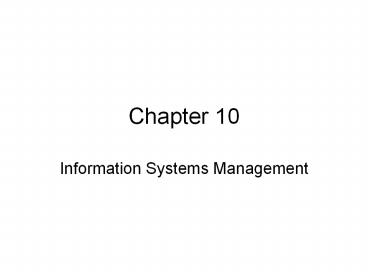Information Systems Management - PowerPoint PPT Presentation
Title:
Information Systems Management
Description:
Data Administration. Outsourcing. Users Rights and Responsibilities ... Data administration. Protect data and ... Data administration: entire data assets ... – PowerPoint PPT presentation
Number of Views:11
Avg rating:3.0/5.0
Title: Information Systems Management
1
Chapter 10
- Information Systems Management
2
Agenda
- Information Systems Department
- Plan the Use of IT
- Manage Computing Infrastructure
- Manage Enterprise Applications
- Data Administration
- Outsourcing
- Users Rights and Responsibilities
- Discussion and Case Study
3
Information Systems Department Functions
- Plan the use of IT to accomplish organizational
goals and strategy - Develop, operate, and maintain the organizations
computing infrastructure - Develop, operate, and maintain enterprise
applications - Protect information assets
- Manage outsourcing relationships
4
Information Systems DepartmentOrganization
- Chief information officer (CIO)
- Data administration
- Protect data and information assets
- Establishing data standards and data management
practices and polices - Technology (CTO)
- Investigate new information systems technologies
- Determines how the organization can benefit from
new IT - Operations
- Manage the computing infrastructure (individual
computers, computer centers, networks, and
communications media) - Monitor the user experience and respond to user
problems - Development
- Create new information systems
- Maintaining existing information systems
- Outsourcing relations
- negotiate agreements with other companies to
provide equipment, applications, or other services
5
Organization Chart
6
Plan the Use of IT
- Align information systems strategy with
organizational strategy - Accomplish organizational goals and objectives
- CIO communicate IS issues to the executive group
- Provide the IS perspective of problems solutions,
proposals, and new initiatives - Develop Priorities and enforce within the IS
department - Prioritize IS project given the constraints of
time and budget - Sponsor Steering Committee meeting schedule and
agenda - Managers from the major business functions
- A forum for users to express their needs,
frustrations, and other issues - Set the IS priorities and decide among major IS
projects and alternatives
7
Manage Computing Infrastructure
- Mirror IS infrastructure with the organizational
structure - Centralized and controlled information systems
for centralized organization - Decentralized information systems for
decentralized organization to facilitate
autonomous activity - Tasks
- Create and maintain infrastructure for end-user
computing - Create, operate, and maintain networks
- Create, operate, and maintain data centers, data
warehouses, and data marts - Establish technology and product standards for
easy management and avoiding incompatibility - Track problems, prioritize services, and monitor
resolutions for end-user - Manage computing infrastructure staff (hiring,
training, etc.)
8
IS Operation Group
9
Manage Enterprise Applications
- Software programs span more than one department
- ERP, EAI, SCM, and other inter department
applications - Tasks
- New applications development (approved by
steering committee) - System maintenance (fixing problems, maintaining
legacy system implementing new requirements,
monitoring resolutions) - Enterprise application integration
- Staff management (sustaining developers and new
application developers, product quality assurance
(PQA) engineers, technical writers )
10
IS Development Group
11
Data Administration
- Database administration a particular database
- Data administration entire data assets of an
organization - Define organizational data standard or metadata
name, official definition, usage, relationship to
other data items, processing restrictions,
version, security code, format, owner, and other
features - Maintain data dictionary
- Define dynamic data policies (data administrator,
senior executives, the legal department,
functional department managers, and others) - Plan disaster-recovery
12
Outsourcing
- The process of hiring another organization to
perform a service - Benefits
- Management
- Obtain expertise
- Avoid management problems
- Free up management time
- Cost Reduction
- Obtain part time services
- Gain economies of scale
- Risk reduction
- Cap financial risk
- Improve quality
- Reduce implementation risk
- International outsourcing issues
13
Outsourcing Alternatives
- Acquisition and operation of computer hardware
- Acquiring licensed software
- Outsource entire system
- Web storefront
- Entire business function
14
Outsourcing Problems
- Lost of control
- Technology
- Intellectual capital
- Wrong priority
- Vendor internal change
- CIO superfluous
- Benefits outweighted by long term costs
- High unit cost
- Mismanagement
- De-facto sole source
- Not get what you are pay for
- No easy exit
- No critical knowledge employee
- Expensive and risky to change vendor
15
User Rights
- Computer resources to proficiently perform work
- Reliable network and Internet connections
- A secure computing environment
- Protection from virus
- Define requirements for new system
- Reliable systems development and maintenance
- Prompt attention to problems, concerns and
complaints - Properly prioritized problem fixes and
resolutions - Effective Training
16
User Responsibilities
- Learn basic computer skills
- Learn standard techniques and procedures for
using application - Follow security and backup procedures
- Protect password
- Use computer resource according organization
policies - No unauthorized hardware modifications
- Install authorized software
- Apply software patches and fixes
- Actively participate in defining the requirements
for new systems - Avoid reporting trivial problems
17
Discussion
- Ethics (309a-b)
- State your response to each of the questions in
page 309a. - State the best corporate policy for the personal
computer usage at work place. - Opposing Forces (321a-b)
- State the best corporate policy for outsourcing
the IT. - Reflections (325a-b)
- State benefits and risks on the international
outsourcing for the U.S business.
18
Case Study
- Case 10-1 Marriott International, Inc. (330-331)
1, 2, 3, 4 and 5
19
Points to Remember
- Information Systems Department
- Plan the Use of IT
- Manage Computing Infrastructure
- Manage Enterprise Applications
- Data Administration
- Outsourcing
- Users Rights and Responsibilities
- Discussion and Case Study






























